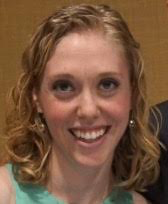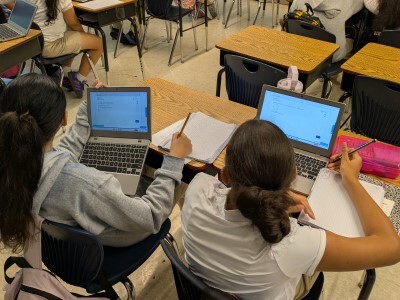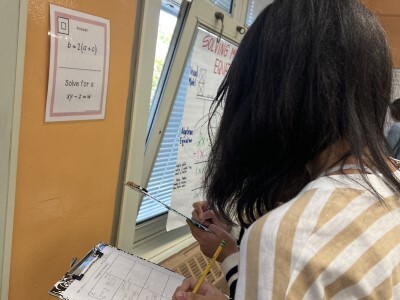Modern Classroom Planning: Educational Change through Bite-Sized Steps
Topics

We’ve all had the experience of truly purposeful, authentic learning and know how valuable it is. Educators are taking the best of what we know about learning, student support, effective instruction, and interpersonal skill-building to completely reimagine schools so that students experience that kind of purposeful learning all day, every day.
When teachers provide self-paced, mastery-based learning, they front-load their work but create rich, self-sustaining units, an effective learning environment, and more time to support student learning.
I vividly remember sitting down in July 2019, to start what felt like an impossible feat. My task was to plan a 6th grade math unit in which each lesson required four separate elements: a video to deliver direct instruction, guided notes to engage students during the video, an assignment to provide practice, and a mastery check to assess. I was intimidated by the amount of work each element would require and most daunted by the video—I couldn’t wait to remove lectures from my classroom but I had no idea how to do that. Luckily, I knew why this was my task.
Planning in this way, as the Modern Classroom Project (MCP) recommends, means “front-loading” the work. But just like when playing a sport, working hard during practice, the “before,” makes the game, the “after,” that much better. While planning is important in any classroom, the careful planning that the MCP model requires leads to rich, self-sustaining units that set the stage for an effective learning environment.
Through this comprehensive planning, I can create materials that facilitate a classroom centered around meeting students where they are, not where they are “supposed to be.” In turn, I can do a few critical things better than I ever had before:
- I can spend ample time with students who need consistent one-on-one assistance
- I can identify the specific misconceptions that hinder student mastery
- I can push students to stay engaged in their learning and become classroom leaders
- I can check in on the emotional needs of students and build strong student habits
So after a long week in July 2019 and many more since then, I have fallen into a pattern of planning that has allowed me to do all the things I just mentioned. In turn, I love teaching again and can see that my students are learning more than they have before. Here’s how I do it.
Step 1: Identifying Skills. First, I look at the assessments and the standards I need to teach in a unit and I list ALL of the skills required to meet these. Breaking down standards into discrete skills, sometimes even creating two skills from what might seem like one, is critical as it keeps lessons short and digestible. I then arrange these skills in sequential order to compile a list of skills that build upon one another. Listing of all skills in a logical, gradual ramp-up in “mental-load” is key; it becomes the skeleton of my MCP unit.
Step 2: Categorizing Skills. Once I have my list, which I often adjust multiple times during the planning process, I set the stage for my classroom differentiation: I categorize the skills. I determine which skills every single student needs to master and figure out which skills are foundational to the unit. These—generally between ⅔ and ¾ of the skills on my list—are my Must Do lessons, which every student will be required to complete. Then I look at what skills will deepen students’ understanding but aren’t essential: I categorize these as Should Do lessons. These usually account for the rest of the skills. Finally, I create Aspire To Do lessons to provide meaningful extension work; these are questions or project-like tasks that require multiple skill sets and lend themselves to multiple solving strategies. These are the most interesting problems and I hope that students will be motivated to complete them.
To help illustrate this classification, take, for example, my sixth grade integer operation unit. A Must Do lesson is “Adding Integers” where students learn how to add integers. A Should Do is “Models for All Operations” where students match multiple types of models to all four integer operations. And an Aspire To Do lesson is a “‘How To’ Project” where students create a presentation explaining an integer operation of their choice.
Step 3: Creating Lesson Materials. Now that I have my skills classified, I can turn them into lessons. Each lesson, as I mentioned before, requires four parts: the video, notes, assignment, and mastery check. I start by creating the mastery check and assignment. I create a question or two that will demonstrate whether students have mastered a skill or not: this is the mastery check, which students must pass to advance to the next lesson. Then I design a set of problems that give students the space to build mastery through practice. Because my mastery checks are designed to be efficient, the assignment is where, through mistakes and revision, the bulk of learning happens.
Step 4: Recording the Video. After that, I turn to the video. The shorter the video, the better, so I create a few slides—between four and seven—with vocabulary and carefully selected examples that each introduce important elements of the skill. I then record myself filling out the slides on Explain Everything. (For more information about recording videos, check out “3 Keys to Effective Instructional Videos.”) At first, recording videos was intimidating as it made my direct instruction feel final. But Edpuzzle, the site I use to add questions to improve student engagement, allows notes and voice-overs to be added which ensures I can edit my instruction. To create notes for students to take while watching the video, I simply print my video’s slides. This not only saves me time as I don't have to create something new, but it also allows students to easily follow along with the video and copy down exactly what they see on the screen. Take a look at this example of a final product:
I repeat this process for each skill on my list, assembling a unit of anywhere between seven and twelve lessons. Before I begin the unit with my students, I have at least four full lessons created and usually one or two of the next lessons’ mastery checks, assignments, and slides made. After that, I finalize or create another one or two lessons a week, depending on how quickly my top students move through the material. When I first started planning and creating these units, I spent about 90 minutes to complete one lesson. This quickly dropped to 60 minutes and now I can create a lesson in about 45 minutes.
Step 5: Grading. And then there is grading. Planning happens before the unit, but there is no way around a lot of grading, especially as I grade all assignments and mastery checks for 100 percent accuracy. I grade as much as possible in the classroom; not only does this reduce my workload after school but it also gives students immediate feedback, which they love and thrive off of. I sit in the back of my classroom where I have pulled a small group of students. (See more on seating in my Modern Classroom.) Then, with students sitting next to me, I check in with them about mistakes, circle other incorrect answers, and have them find and fix these misconceptions, referring them to the video, their notes, or peers before they seek my help again. Whatever work I don’t grade with students, I grade after school.
Ultimately, such thorough planning not only sets my classroom up for success, but it also allows me to see connections within units and between units that I hadn’t before which, in turn, makes my lesson and units richer. I know I am creating relevant resources not only for my students but also for their families.
And what I love most about my detailed MCP planning process is that I am modelling what I want my students to do; I break down each intimidating unit into bite-sized pieces just as I want my students to do when they encounter a difficult math problem. To all those facing your own insurmountable teaching task, just like with anything new or intimidating in life, give yourself grace and focus on one thing at a time. You will make mistakes or try something that doesn’t work and you will learn from it! Your first unit will be the hardest to plan but that, in and of itself, is incredibly valuable.
Related Posts
- From Struggle to Success: A Teacher’s Journey through Professional Learning and Innovation, Joseph Chaves Lombardi, Math Teacher in Connecticut. When teachers have choice in professional learning, they can discover the innovative, research-backed approaches to teaching that work for them.
- My Students Aren't Lazy but Labeling Them Lazy Is, Laura Domingo, English Language Arts Teacher in Indiana. Blended, self-paced learning can create time for teachers to move beyond shortcut labels to get to know students and their true potential for learning.
- A Slight Push for Our Teaching Practice, Perla Luján, Academic Coach in Mexico City, Mexico. Educators want students to have what they really need from school; the biggest challenge is how to improve the learning experience.
Photo at top by Allison Shelley for American Education: Images of Teachers and Students in Action.




